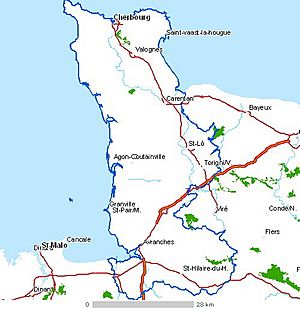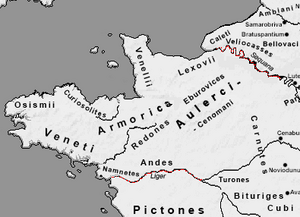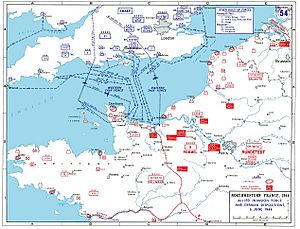Cotentin Peninsula facts for kids
The Cotentin Peninsula, also called the Cherbourg Peninsula, is a piece of land that sticks out into the English Channel from the coast of France. It's located in Normandy. To its west are the Channel Islands, and to the southwest is the Brittany Peninsula.
The Cotentin Peninsula is part of the Manche department in the Normandy region. The biggest town on the peninsula is Cherbourg, which is on the north coast. Cherbourg is a very important port on the English Channel. The western coast of the Cotentin is known as Côte des Îles (which means "Islands Coast") because it faces the Channel Islands. You can catch ferries from ports like Carteret and Dielette to islands like Jersey, Guernsey, and Alderney.
History of the Cotentin Peninsula
Long ago, the Romans called this area Armorica. The town of Coutances was the capital of a Gaulish tribe called the Unelli. In 298 AD, during the time of the Roman emperor Constantius Chlorus, Coutances was named Constantia. Later, under the Carolingian rulers, the area became known as the Cotentin. It was controlled by local leaders called viscounts, often from the Saint-Sauveur family.
In the 800s, Vikings settled in the Cotentin. In the early 900s, it became part of Normandy. Many place names in the Cotentin come from the Norse language, which the Vikings spoke. For example, La Hague and La-Hougue both come from the Old Norse word haugr, meaning a hill or mound.
For a long time, it was hard to get to the Cotentin Peninsula in winter. This was because marshlands cut off the higher ground. This is why sometimes in history, the Cotentin was even called an island!
King Alan the Great of Brittany fought successfully against the Norsemen. Because of his victories, the Cotentin Peninsula became part of the Duchy of Brittany. After he died, the Norsemen invaded and took over Brittany from 907 to 939. Even though Alan's grandson, Alan II, Duke of Brittany, eventually drove them out, the rulers of Brittany after Alan the Great were not as strong. Brittany continued to face Norse invasions and Norman raids. Eventually, the Cotentin Peninsula was lost to Brittany and became part of Normandy.
In 1088, Robert Curthose, who was the Duke of Normandy, gave the Cotentin to his brother Henry. Henry later became King Henry I of England. As the count of the Cotentin, Henry built his first power base here.
During the Hundred Years' War, King Edward III of England landed in the bay of La Hogue. He then went to the Church of Quettehou. It was there that Edward III made his son, Edward, the Black Prince, a knight. You can still see a plaque next to the altar that remembers this event. The naval Battle of La Hogue in 1692 was fought near Saint-Vaast-la-Hougue and Barfleur.
The town of Valognes was a popular social spot until the French Revolution. It was even nicknamed the Versailles of Normandy because of its grand houses and castles. Many of these beautiful buildings were destroyed during World War II.
During World War II, a major part of the 1944 Battle of Normandy happened in the Cotentin. The westernmost part of the D-Day landings took place at Utah Beach, on the southeastern coast of the peninsula. After the landings, there was a big campaign to take control of the peninsula and capture Cherbourg.
Economy and Jobs
The main way people make a living in the Cotentin is through farming. Dairy farming, which means raising cows for milk and cheese, is very important. Along the west coast, famous vegetables like the carrots of Créances are grown. The well-known "Florette" brand of fresh salads was started in Lessay. The region is also famous for its shellfish, like oysters from Saint-Vaast-la-Hougue and Pirou. Other local products include alcoholic drinks like cider and calvados, which are made from apples and pears grown nearby.
The region has two important Nuclear power plants. One is the Flamanville Nuclear Power Plant. The other is the COGEMA La Hague site, which is a large complex for processing and storing nuclear waste. This nuclear power industry provides many jobs for people in the region.
There are also two important naval shipyards in Cherbourg. The state-owned shipyard, DCNS, has been building French nuclear submarines since the 1960s. A private company called CMN builds frigates and patrol vessels for different countries, mostly from the Middle East.
Tourism is another important part of the economy. Many visitors come to see the D-Day invasion beaches, including Utah Beach in the Cotentin. At Sainte-Mère-Église, a few miles from the beach, there is a museum about the 82nd Airborne Division and the 101st Airborne Division, two famous American paratrooper divisions. The Cité de la Mer in Cherbourg is a museum about the ocean and underwater exploration. Its main attraction is the Redoutable, which was the first French nuclear submarine, launched in 1967.
Culture
Because it has been somewhat isolated, the Cotentin is one of the last places where the Norman language is still spoken. Alfred Rossel, a Norman language writer from Cherbourg, wrote many songs that are an important part of the region's heritage. Rossel's song Sus la mé ("on the sea") is often sung as a patriotic song for the region.
See also
 In Spanish: Cotentin para niños
In Spanish: Cotentin para niños




